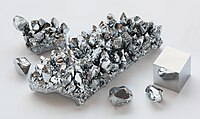
Photo from wikipedia
ABSTRACT Kimberlite is the host rock of diamonds and varies widely in geological and mineralogical features as well as color, processing capability, and dewatering characteristics. This study investigated the dewatering… Click to show full abstract
ABSTRACT Kimberlite is the host rock of diamonds and varies widely in geological and mineralogical features as well as color, processing capability, and dewatering characteristics. This study investigated the dewatering behavior of problematic Angolan kimberlites. The presence of clay minerals in kimberlite causes difficulties in dewatering due to high flocculant demand, poor supernatant clarity, and low settling rates. Identifying critical parameters governing the settling behavior will assist in managing the settling behavior of different kimberlite slurries. The influence of particle size, pH of the kimberlite slurry, cation exchange capacity, exchangeable sodium percentage, and smectite content of the kimberlite on the settling rate were investigated for 18 different African kimberlite samples. The settling rate and slurry bed compaction during natural settling were also measured for the kimberlite slurries. Seventeen different Angolan clay-rich kimberlites and one South African clay-rich kimberlite were tested, and, except for two kimberlites, colloidal stability was experienced during natural settling. The pH values of the kimberlite slurries ranged between 9 and 11, which is similar to the pH band where colloidal stability was found during earlier research. The results indicate that colloidal stable slurries were experienced with kimberlites that had exchangeable sodium percentages as low as 0.7%. The cation exchange capacity of the various kimberlites differentiated more distinctly between colloidal stability and instability. A new model is proposed whereby clay-rich kimberlites with a cation exchange capacity of more than 10cmol/kg will experience colloidal stability if the pH of the solvent solution is within the prescribed pH range of 9–11.
Journal Title: Mineral Processing and Extractive Metallurgy Review
Year Published: 2018
Link to full text (if available)
Share on Social Media: Sign Up to like & get
recommendations!